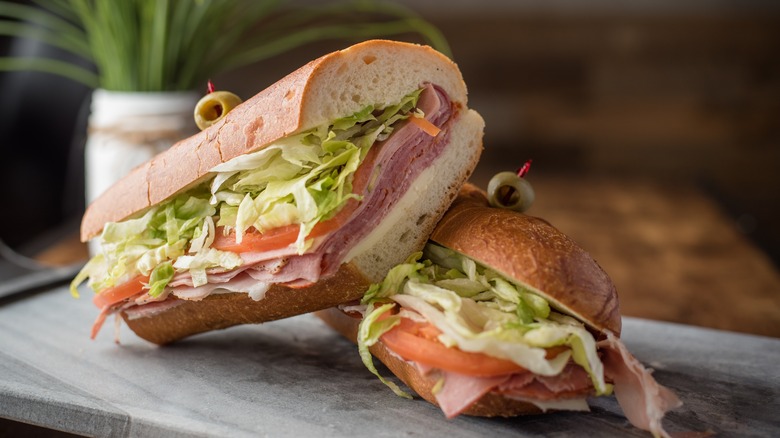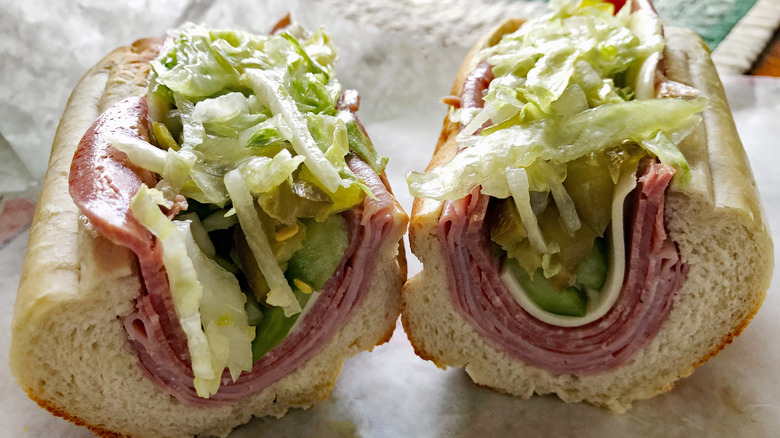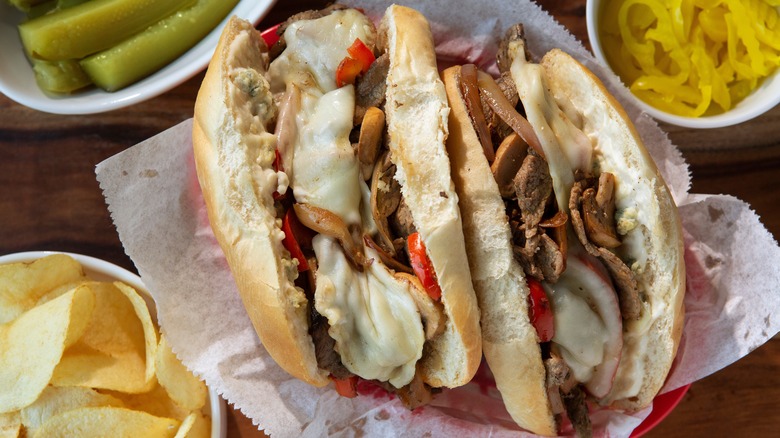The Working Class Origins Of The Grinder Sandwich
The tradition of the Great American Sandwich runs deep. A point of pride for many, and contention for many more, the history of our nation can be traced through the favored sandwiches of the people who built it — and it's hard to find one more storied than the humble grinder. Also known as a sub, a hero, a hoagie, an Italian, or even a po'boy, the number of monikers alone is a record of its history. Though it has had many iterations over the last century, this beloved sandwich remains a culinary landmark along the Eastern Seaboard.
But like many American icons, the sandwich finds its origins in the most humble beginnings. Though the real story has likely long faded into folklore, the prevailing theory traces the grinder to an Italian shopkeeper named Benedetto Capaldo, who immigrated to New London, Connecticut, in 1913. By the 1920s, Capaldo's sandwiches, served in the familiar roll we know today and loaded with meat, became extremely popular with local dock workers — known colloquially as grinders, because the crusty Italian roll was so chewy that you had to "grind" through it.
Those dock workers, in turn, were later responsible for the name "sub" coming to be. New London was a hotspot for submarine construction during World War II, and as those dock workers built more submarines and ate more sandwiches, the iconic nickname was born. Over time, subs grew into a staple on-the-go lunch for much of America and are now a worldwide phenomenon.
The origins of the sandwich are actually disputed
Though the theory of dock workers building submarines during World War II fueled by Benedetto Capaldo's sandwiches has a certain romance to it, it's not quite so simple — newspaper records from Pennsylvania and Delaware contain mentions of subs predating World War II by some four years. Many claim that the sandwich was actually invented in New Jersey by another Italian, Dominic Conti, who came to the U.S. in the late 19th century.
Conti's original sandwich recipe reportedly consisted of a long, crusty roll stuffed with layers of cold cuts, salad, vinegar, and dried herbs, with a slice of cheese on either side to stop the bread from getting soggy — in fact, it sounds a lot like the grinder sandwich that went viral on TikTok. There isn't much information on Capaldo's sandwiches, and Conti's seems to be the first definitive recipe for the grinder in its most iconic modern-day form. But it seems far more likely that, rather than having been invented by one person, the sandwich simply evolved naturally: a result of different communities coming to America and adopting the customs, cuisines, and ingredients of where they eventually landed. But through all the myths, one thing remains constant: The grinder finds its origins in the docks and shipyards of the East Coast.
What makes a grinder a grinder?
As for the sandwich itself — there is some conflict over what exactly can be called a grinder. The bread seems to be just about the only thing to have remained constant through the sandwich's history, though — a long Italian roll, crusty on the outside, chewy within. But that bread can contain multitudes.
What you call this fabled sandwich will, most of the time, depend on where you are. Some insist that a grinder must be served with hot fillings like meatballs. Philadelphians claim it should be toasted — see the iconic cheesesteak. The Cajun community in Louisiana gave birth to the po'boy around the same time as Benedetto Capaldo created his subs. Sauce-filled po'boys used French bread instead of Italian, and were filled with fries and seafood.
Despite over a hundred years of variation, there is something poetic about the sandwich that most people now associate with the name following (almost exactly) Dominic Conti's original recipe. It's a welcome appreciation of its origins, reminding us how food can bridge cultural divides. A humble sandwich invented by working-class immigrants over a hundred years ago has taken on a life of its own: It's accessible, affordable, and, of course, delicious. It's genuinely democratic food: There's a grinder for everyone. Truly, a fitting ambassador for American cuisine.



